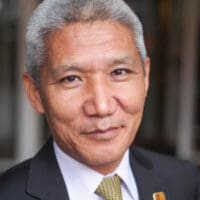Filmed during Mind & Life Institute’s “Mind & Life XIII: Investigating the Mind: The Science and Clinical Applications of Meditation” on November 8-10, 2005.
Session Two – Possible Biological Substrates of Meditation
SPEAKERS:
Robert M. Sapolsky
Wolf Singer
Modern scientific knowledge of how stress affects the brain and body and how the brain can become re-organized to produce states of focused attention that promote learning and change has burgeoned over the past decade. This session will showcase some of the latest scientific research on these topics to provide a foundation for the likely substrates upon which meditation might operate. In addition, a detailed understanding of the biological substrates of stress and plasticity will provide a framework for the design of new research that is based upon this recent understanding.
MODERATOR: Richard J. Davidson
INTERPRETERS:
Thupten Jinpa
B. Alan Wallace
PANELISTS:
His Holiness the 14th Dalai Lama
Robert M. Sapolsky
Wolf Singer
Matthieu Ricard
Esther M. Sternberg
B. Alan Wallace
SPEAKERS
Robert Sapolsky: The neurobiology of the adaptive and the deleterious features of stress
Few of us will succumb to cholera, smallpox or scarlet fever. Instead, we die from diseases of Westernized lifestyle, which are often diseases worsened by stress. When the stress-response is mobilized by the body because of a typical mammalian stressor (e.g., a sprint from a predator), it is highly adaptive. However, when activated in the classic manner of Westernized humans (i.e., chronic psychosocial stress), it is pathogenic. The presentation will consider this dichotomy, as well as new directions of research needed for understanding the neurobiology of stress and stress management.
Wolf Singer: Synchronization of brain rhythms as a possible mechanism for the unification of distributed mental processes
The brain is organized in a highly distributed way and lacks a convergence center for the coherent interpretation of the numerous parallel processes that occur simultaneously within functionally specialized regions. This raises the question how subsystems are integrated so that their computational results can give rise to unified percepts. It is proposed that this integration is achieved at least in part by the synchronization of oscillatory activity in the beta- and gamma frequency range. This interpretation is in accordance with neuronal activation patterns recorded during states of focused attention and meditation, since attentional processes serve binding functions, heighten awareness, and lead to the unification of distributed processes.
Participants

Robert Sapolsky, PhD
Stanford University

Wolf Singer, MD, PhD
Max Planck Institute

Richard J. Davidson, PhD
William James and Vilas Research Professor of Psychology and Psychiatry and Founder & Director of the Center for Healthy Minds, University of Wisconsin-Madison. Founder and Chief Visionary for Healthy Minds Innovations, Inc.

Thupten Jinpa, PhD
Board Chair, Mind & Life Institute



